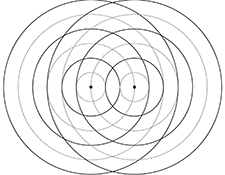
Two-source interference
Variant i Interactive tutorial lecture Other Variants Dynamics first
This tutorial lays a foundation for physical optics. It uses water, instead of light, to help students relate the representations and formalism to real-world phenomena.
Topics Waves and optics / Physical optics: representations, superposition, symmetry, constructive & destructive interference, frequency & wavelength, path-length difference, periodic circular waves, wave (or pulse) speed, and superposition
Materials
Materials by the UW team
- Group Handout



- Clicker Questions Only


- Instructor Guide


- Pretest



- Pretest for LMS



- Exam Questions



- Equipment List

Tutorial details
Section I: Periodic circular waves
In this section, students explore the behavior of periodic circular waves from a single source and describe how the locations of crests and troughs change over time.
Section II: Two sources a fixed distance apart
Students are shown diagrams of the wavefronts from two sources and are asked to compare the speed, wavelength, frequency of each wave. They identify points at which the water surface is (1) farthest above equilibrium, (2) farthest below equilibrium, and (3) at equilibrium. They then consider how the displacement of the water changes over time.
Section III: Path-length difference
In this section, students calculate path-length differences for various points on their diagrams. They then relate path-length differences to lines of maximum constructive and destructive interference.
In Questions H-L, students observe a video demonstration to explore the effects of changing the source separation.
For instruction tips, login or register as a verified educator to see the Instructor Guide.
Prerequisites
Prerequisite tutorials
The Superposition of pulses and Reflection and transmission of pulses tutorials are prerequisites to Two-source interference.
Other prerequisites
It is expected that students have a basic understanding of wavelength, frequency, and superposition.
Equipment
Special Instructions
Included with this tutorial is an optional handout showing an enlargement of the wavefront diagram used throughout.
List
- handouts
- tutorial instructor slides
- tutorial student slides or worksheet
Research
- B. Ambrose, R. Steinberg, P. Shaffer, and L. McDermott, An investigation of student understanding of single-slit diffraction and double-slit interference, Am. J. Phys. 67 (2), 146 (1999).
- K. Wosilait, P. Heron, P. Shaffer, and L. McDermott, Addressing student difficulties in applying a wave model to the interference and diffraction of light, Am. J. Phys. 67 (S1), S5 (1999).
Coming Soon! We hope to release the discussion section on each tutorial soon.

